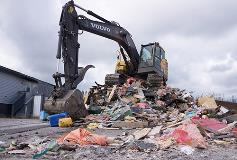Assessing the Damage, Moving Forward

When disasters occur in Alberta, a small team of Professional Engineers with the Alberta Emergency Management Agency travel the province to assess infrastructure damage and determine whether repairs are eligible for funding from the Disaster Recovery Program (DRP). The program provides financial assistance to municipalities and citizens who face uninsurable losses in the wake of a disaster.
Ron Maine, P.Eng., FEC, joined the team June 13. One of his first assignments was assisting the Regional Municipality of Wood Buffalo (RMWB) in evaluating wildfire damage. He worked with RMWB staff to help them determine which recovery projects would qualify for the DRP funding and to prioritize which were the most urgent. “The safety of the people is primary,” says Mr. Maine.
Heavy firefighting equipment damaged roads, curbs, sidewalks and trails, while ruts made by the machinery caused drainage issues. The fire burned everything from retaining walls, parks, playground structures and outdoor facilities to asphalt, street signs and street lights.
In Anzac, the roof collapsed on a new wastewater treatment plant. Water reservoirs in Beacon Hill and Abasand sustained major damage. At the landfill, surface pipes and an instrumentation building for an new aerobic carbon offset project were destroyed before it was even commissioned (it will be the world’s largest when its fixed).
But considering the magnitude of the fires that tore through the region, damage to RMWB infrastructure was relatively minor compared to devastation in residential neighbourhoods. “Overall, we were very fortunate in terms of municipal infrastructure,” says Kevin Scoble, P.Eng., RMWB’s Deputy Chief Administrative Officer.
Still, it could take two or three years for all the municipal damage to be fixed. In the meantime, the municipality is dealing with fire-related infrastructure challenges as they arise.
In July, for example, a one-in-100-year rainstorm caused roads and homes to flood. The problem was made worse because of runoff caused by lost trees and vegetation and baked soil. Slope stabilization studies have also been conducted to address challenges that vegetation loss poses.
The province has already provided the RMWB with $87.5 million to help with the cost of the emergency response, evacuation, cleanup, and repairs. The municipality’s initial estimate of total response costs is around $175 million.
Once the recovery repairs are complete, the province will apply to the federal government under the Disaster Financial Assistance Arrangement (DFAA) for cost sharing support.
Moving Forward
The emergency has passed, but things haven’t slowed for the RMWB as rebuilding moves forward.
While several neighbourhoods need to be rebuilt, one of the biggest challenges was in a community named Waterways, where about 90 per cent of the homes were destroyed. Because the community is in a floodplain along the Clearwater River, it was initially unclear if the 238 homeowners could rebuild because new legislation banning development in areas prone to flooding.
“The problem was legislation didn’t contemplate rebuilding a whole community that had been wiped out by a natural disaster,” says Mr. Scoble.
In October, an agreement was reached that will allow residents to rebuild, but it will require the municipality to implement some major flood mitigation projects. That could include construction of a demountable flood wall, which can be set up in the spring to protect homes from potential flooding caused by ice jams during breakup.
Construction of new collector routes out of residential communities are underway and engineers have also been putting forth proposals for new arterial routes out of Fort McMurray, as well as a major new highway to provide an alternate evacuation route. Right now, Highway 63 is the only way in and out.
Whatever new infrastructure projects are approved should address the increased risks caused by climate change, says Mr. Scoble. He points out that in the past three years, Fort McMurray has been hit hard by three floods and the wildfires, which followed an unseasonably warm winter and spring with little precipitation.
“Canada’s infrastructure is not ready for climate change, and we were a perfect example of that,” he says. “We’re going to have to take a very strong look at our risk assessments, ranking all mitigation projects relative to risk. The fire is first and foremost on everyone’s minds, it was tragic, devastating and graphic, but we want to make sure we’re not taking our eye off the ball and not correcting other problems that are going to happen much more frequently,” he says.
“The old standards aren’t going to work anymore. Our first major storm mitigation retrofit project, just completed, is built for a four-hour, one-in-100-year storm.”
